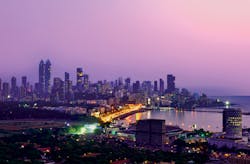The government in new delhi wants to work with the us to develop its shale gas reserves
MANISH VAID, OBSERVER RESEARCH FOUNDATION, NEW DELHI
ACCORDING TO the BP Statistical Review 2016, India is the third-largest energy consumer in the world after China and the United States. Further, India's energy consumption (growth projected at 4.2% per year by BP Energy Outlook 2035) is forecast to be the fastest among all major economies. During this period, India's increased domestic energy production is expected to fall short of robust energy demand, pushing it to energy imports that could risk its fiscal stability.
To meet its energy requirements at affordable prices while using cleaner fuels, India has decided to reset its energy basket in a significant way, wherein the role of natural gas would be significant. India made the decision to increase its use of natural gas from 6.5% at present to 15% to push towards a gas-based economy. This will accommodate its energy needs while addressing the issue of rising greenhouse gas emissions by using more of the clean-burning fuel.
To meet this objective, increasing the production of domestic natural gas and cheaper liquefied LNG imports has been prioritized by the government of India. Earlier, the shale gas revolution in the US, together with the precarious situation of India's domestic energy resources, prompted the government to explore unconventional energy resources, such as shale gas, coal bed methane, and gas hydrates in India. Such efforts can now be pushed further to align with India's objective of moving towards a gas-based economy.
© Sapsiwai | Dreamstime.com
Recently, while India benefitted from prolonged low oil prices that resulted from the unexpected growth of US shale oil output vis-à-vis OPEC's relentless oil production, it is yet to accrue any substantial benefits from the US revolution per se, as none of India's shale reserves have started commercial production.
However, to support India's effort to develop its own shale gas reserves, the US State Department (DOS) signed a Memorandum of Undertaking (MoU) with India's Ministry of Petroleum and Natural Gas (MoPNG) on Dec. 6, 2010. Under this MoU, the DOS agreed to cooperate with MoPNG in shale gas resource assessment, technical studies, regulatory framework consultations, training, and investment promotion through the exchange of experiences and best practices and through study tours.
Subsequently, several agencies from time to time have made assessments regarding the potential of shale resources in the Indian sedimentary basins. In January 2011, Schlumberger made an initial gas-in-place estimate of 300 to 2,100 trillion cubic feet (tcf) under a shale gas pilot project for Oil and Natural Gas Corporation Limited (ONGC) in the Damodar Valley basin. In April 2011, the US Energy Information Administration assessed risked gas-in-place of 290 tcf with technically recoverable resource of 63 tcf, which was upgraded to 584 tcf in 2013 with additional estimates of shale oil at 87 billion barrels in four basins, namely, the Cambay Onland, Damodar, Krishna Godavari Onland, and Cauvery Onland.
In January 2012, the United States Geological Survey estimated 6.1 tcf of technically recoverable shale gas in three basins, namely, Cambay, KG & Cauvery. Further, while in 2013, ONGC put the shale gas estimates to 187.5 tcf in five basins, namely, Cambay, KG, Cauvery, Ganga & Assam and Assam - Arakan, Central Mine Planning and Design Institute estimated 45 tcf of gas in six basins, namely, Jharia, Bokaro, North Karanpura, South Karanpura, Raniganj, and Sohagpur.
Soon after these estimates, in October 2013, the Indian government approved the policy guidelines for the exploration and exploitation of shale gas and oil by various national oil companies under the nomination regime in their onland Petroleum Exploration License/Petroleum Mining lease areas.
Accordingly, under Phase-I of assessment ONGC and Oil India Limited (OIL) have been allotted 50 and 6 blocks, respectively. In Phases II and III ONGC will carry out exploration in 75 and 50 blocks, respectively, while OIL will carry out exploration in 5 blocks each in Phase II and III.
According to the Press Information Bureau, so far, ONGC has drilled 20 assessment wells for shale gas and oil. OIL has completed geological and geophysical studies and geochemical analysis in its identified areas besides completing Conventional Core in one well in Rajasthan.
ONGC, in collaboration with Schlumberger, drilled its first R&D well (RNSG-1) in a pilot project near Durgapur in West Bengal in January 2011, which produced shale gas from the Barren Measure formation of Permian age.
Thus, varied estimates for shale gas presence in India calls for extended exploration and assessment, wherein US cooperation would be needed on a continual basis, which could help bring up early commercial production from shale resources in India.
However, in India the exploration of shale gas and oil are still at the preliminary stage as 'above ground factors' are expected to delay its commercial production further. The biggest apprehension in this regard is with the contamination of aquifers due to hydraulic fracturing.
In addition, sourcing of water of around 100,000 barrels per well for multi-stage fracking would be a daunting task at places of shale gas reserves, such as Cambay, Gondwana, and Krishna-Godavari, and the Indo-Gangetic plains due to water stress issues.
Additionally, acquiring a land in a densely-populated country like India is a sensitive issue with political ramifications. In the US, underground resources are owned by landowners who often provide access to exploration and production for a signing bonus and royalties. In India , there is high potential for significant misalignment between the government, which owns the mineral rights, and the interests of surface owners or agricultural land users.
Therefore, while India could benefit from extended cooperation with the US on shale gas exploration in the future, addressing 'above the ground' challenges, particularly with respect to water and land, should be prioritized through cooperative federalism.
India has recently reformed its upstream sector by introducing its new Hydrocarbon Exploration and Licensing Policy, which could go a long way to attract prospective investors at a time when only 19% of the total 3.14 million square kilometers have been extensively explored. Such a step is expected to boost domestic production of oil and gas.
ABOUT THE AUTHOR
Manish Vaid, a junior fellow at Observer Research Foundation, researches energy policy and geopolitics. He holds an executive post-graduate diploma in petroleum management (with a specialization in the oil and gas sector) from Pandit Deen Dayal Petroleum University, Gandhinagar, Gujarat.
Views expressed here are those of the author.



